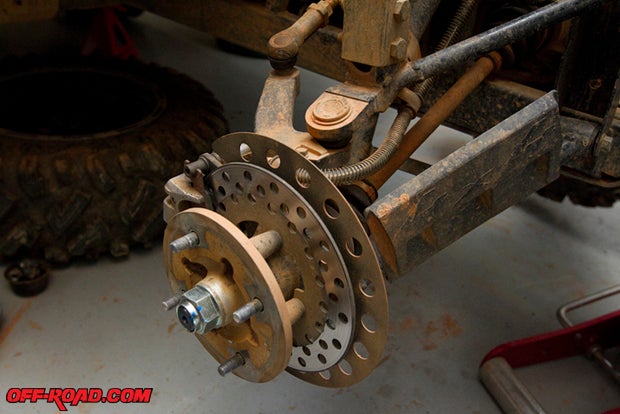
No matter how well you care for your ride, whether it be an SXS or an ATV, you will eventually have to replace parts to keep it safe. There are some parts that need to be looked at closely to insure that in control is where the machine stays. In this article I wanted to show how to replace the ball joints on your SXS. This can be a very tricky and difficult process, so Iíll try to keep it simple to understand.
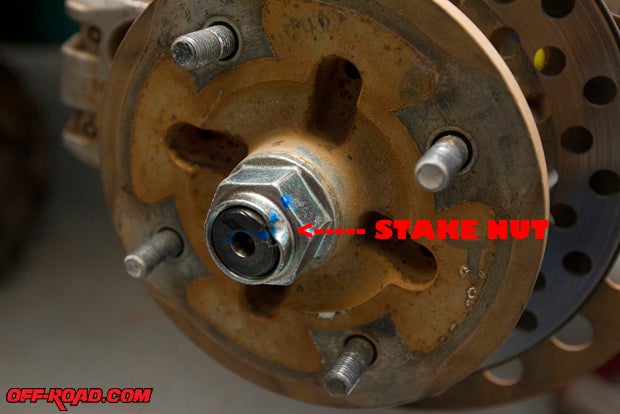
Other ATV, UTV Tech Stories:
If at any time you feel this skill set isnít something you have, then I suggest taking the ride to a dealer for professional help. Always wear adequate eye protection and be aware of the risks involved when working on your machine. Letís dig in!
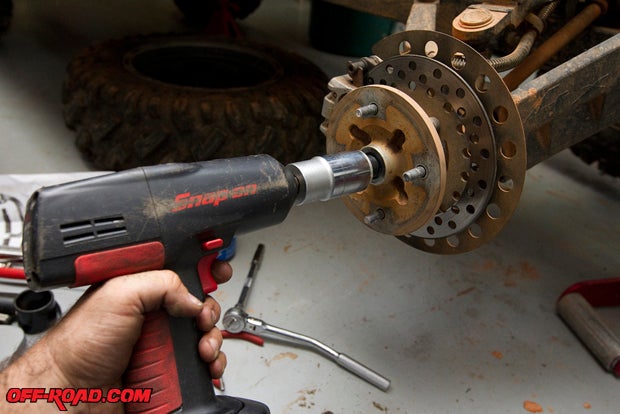
As with all of my technical articles I start with a clear clean shop to work in and plenty of room to work around the machine. Having a service manual on hand is also a recommended part but it is not required for the replacement. The other preferred items would be very good lighting and a couple of jack stands to support the machine. There are a few specialized tools but unfortunately we did not have these on hand. This means that just like you we had to stop and think clearly about what we could use to get the ball joints off the machine.
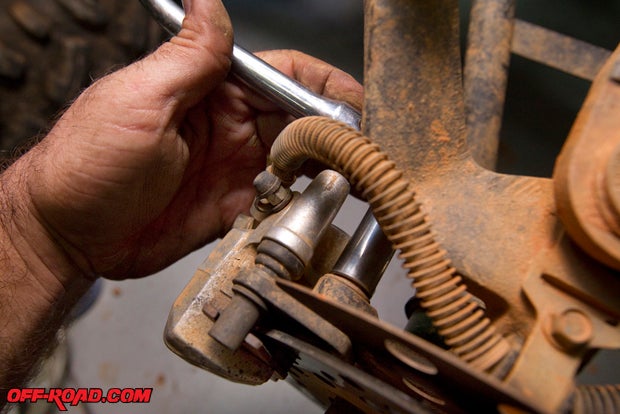
The first step is simple and just involves jacking the SXS up and stabilizing it for the job. Remove the wheel to expose the steering knuckle to be serviced. On our Rhino the steering knuckle has a ball joint on the top and the bottom. With a good stable Yamaha Rhino we remove the right front wheel.
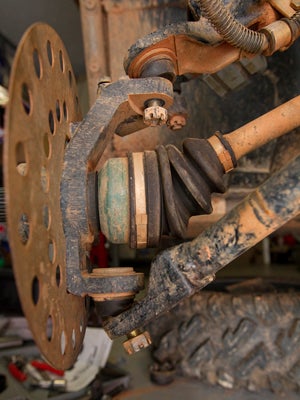
The stake nut would be our next task. The stake nut is a nut that has a thinner outer rim that is staked into the keyway on the half-shaft or axle. Using a center punch simply tap the punch under the edge of the stake nut where it is pressed down and then remove the nut. Youíll need some impact force to get this puppy loose as its pretty snug on the axle. The stake nut will need to be replaced according to Yamaha standards, as it cannot really be reused to successfully hold the nut on the axle.
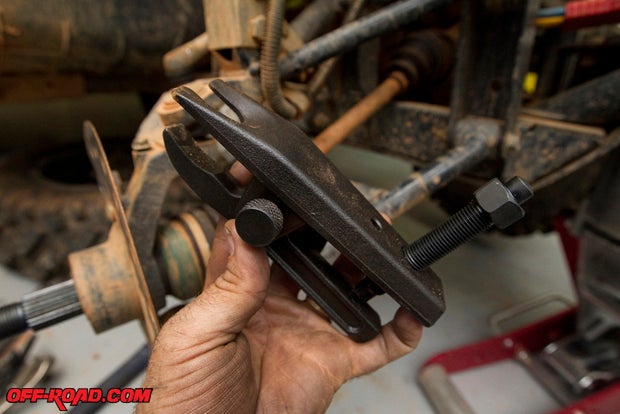
Our brake caliper is the next order of business as it holds the disc between the jaws of the caliper and this Disc is attached to the wheel hub. This caliper has two 12mm bolts on the caliper itself but to be able to sit the caliper out of the way there is a 10mm bolt holding the brake line to the top of the steering knuckle.
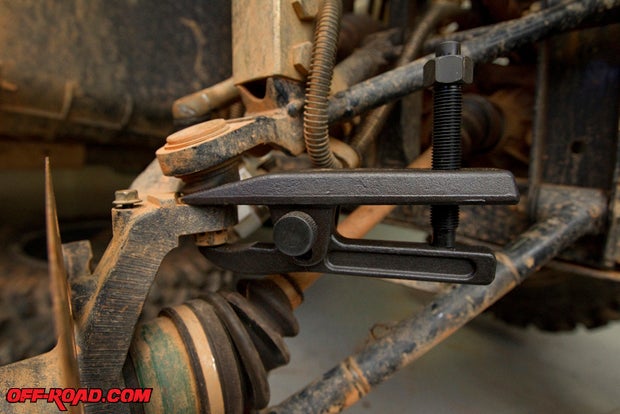
Remove the wheel hub and using a pair of needle nose pliers, remove the cotter pins from the upper and lower castle nuts on the bottoms of the ball joints. These cotter pins will also need to be replaced with new just to be sure there are no problems in the future days of riding.
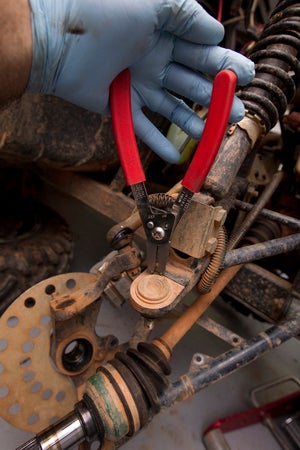
After the castle nuts are loose I left them on the bolt end of the ball joint so I didnít mess up any threads when I use the ball joint separator. This is a Harbor Freight tool that has saved us time and time again. It is a relatively cheap tool as well. The ball joint separator allowed me to remove the joint from the upper and lower a-arms.
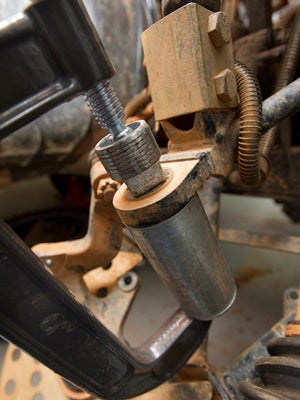
Our next move was to remove the snap rings from the ball joints as these actually help hold the joint in place. A set of snap ring pliers is also another cool tool to have as most of the ATVís and SXSís I work on have some type of inner or outer snap rings somewhere. The ball joint kits come with new snap rings so be sure to use them.
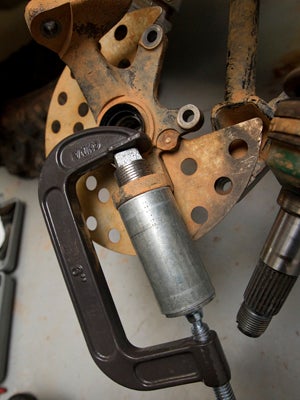
This is where we had to use our ingenuity to successfully remove the ball joints. A trip to Home Depot and some searching around the plumbing department I was able to find a few things to help me get the ball joints off. First off you need something to push the joint out of the knuckle. This will require a large C-clamp. Get a good one because it takes a lot of pressure to get the joint free of the knuckle and trust me, the cheap ones just bend under pressure.
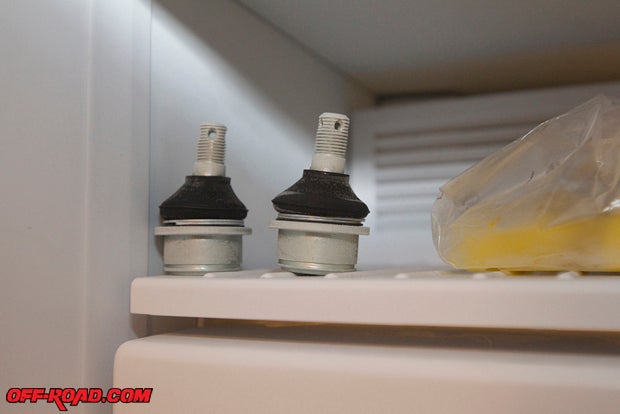
The fact that our Rhino ball joints will fit perfectly in some sizes of galvanized pipe is a great start, as youíll need something to push the joint into. We found a piece of galvanized pipe that would fit perfectly over the rubber grease cap but against the face of the ball joint as well. The best part was I convinced the plumbing employee to cut the threads off the pipe and even chamfer the inside of the pipe so I didnít pinch or tear the grease boot on the ball joint.
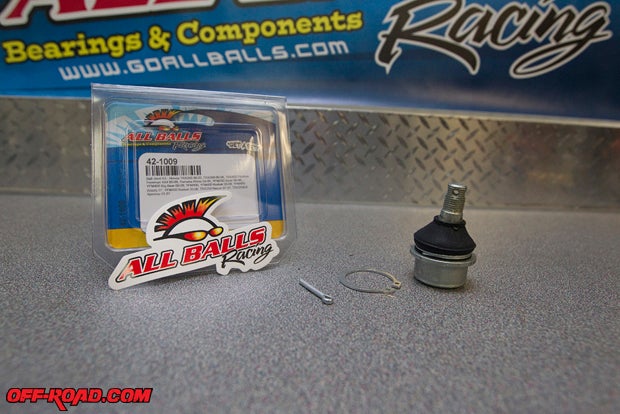
Using a galvanized plug that I had ground down the threads on, I was able to push the ball joint right out into the largest of the three pieces of piping I had bought. Then I just duplicated that same process with the lower joint. The good thing about the plug was that the end of my first c-clamp fit down inside the plug and wasnít roaming all around the top of the ball joint.
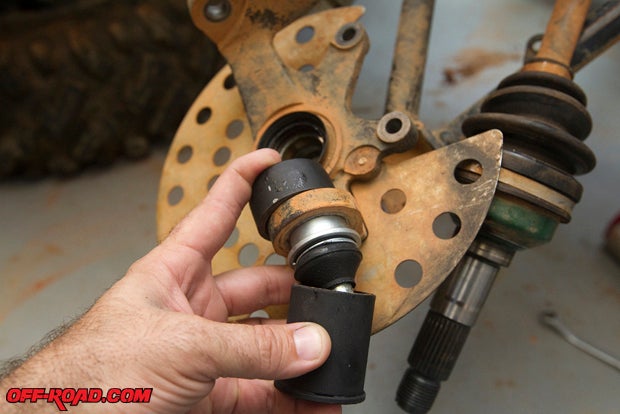
I forgot to mention that it is always good to put the new ball joints into the freezer when you start the removal process so they are good and cold when the reinstall takes place. The metal will shrink slightly in the cold and this allows for an easier install. I know this may sound crazy but it does make the new ball joints easier to install.
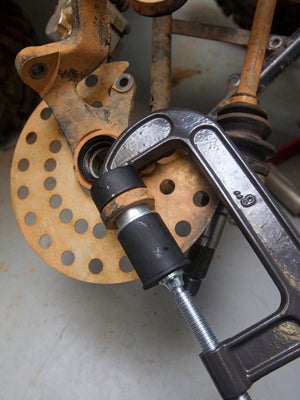
We always look for great products to be used in the maintenance of our machines. This just gives us the confidence that the product will have a less chance of failure when out on the trail. Our choice for the ball Joints was a company called All Balls. The guys at All Balls have the expertise to get us the best product for the best price and we have trusted many rotating parts to them base on their experience. All Balls not only handles ball joints but wheel bearings, seals and much more so check them out at http://www.allballsracing.com/.
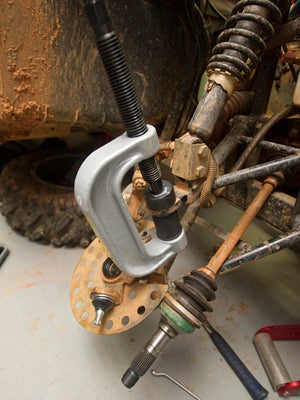
To reinstall the joints we needed one more piece of galvanized pipe that would fit over the top of each hole where our ball joints would come through. This allows us to have a place to clamp to and also lets the joint come through the steering knuckle with out any trouble. With the longer and larger diameter pipe sections in place we pressed the lower ball joint back into the knuckle. This is when we figured out that the cheap c-clamp I had purchased for a sweet $6 dollars was indeed just a six-dollar throw away clamp. I had to break out the big gun to finish the install and then on to the upper joint. Large automotive ball joint remover kits can be purchased almost anywhere that sells automotive parts but the adaptors never fit the atv or sxs applications. This is another Harbor freight tool that we used and I think it was only around $40!!
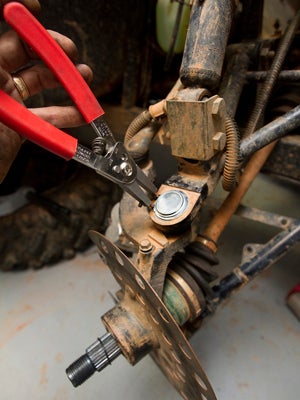
So from here its just a matter of reinstalling the parts that were removed in the beginning just in reverse order. Its always good to check the brake pads while the caliper is off the machine and donít forget to install a new stake nut so the wheel doesnít fall off on the trail.
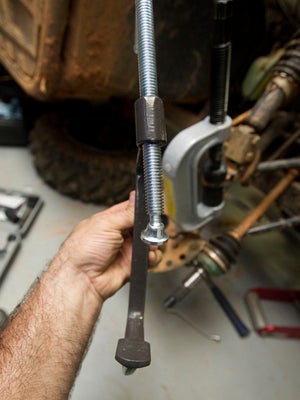
These type of repairs can be inherently dangerous to perform, they require patience and a good mechanical mind set. The fact that you are dealing with the front suspension and essentially the ability to control your off road ride is very important when considering this as a do-it yourself type repair. Again, if at any time you feel uncomfortable do not proceed but take the ride to a dealer or mechanic.
RS
Other ATV, UTV Tech Stories:


 Your Privacy Choices
Your Privacy Choices